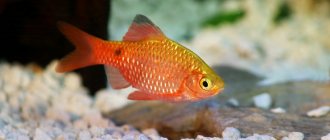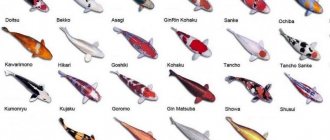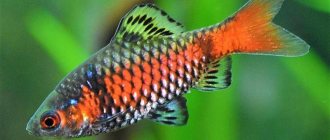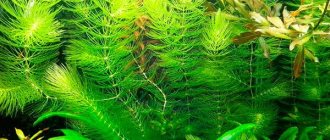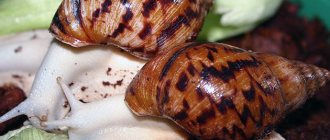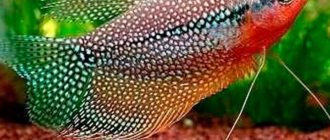The Helena snail is a predatory mollusk that eats other snails in the aquarium, except those that are significantly larger than it. This armored snail eater allows you to control the number of shellfish of other species and prevent an overabundance of coils. The appearance of Helen's predatory snails is attractive, and they fit beautifully into the home aquatic world. The tiger coloring of the shell suits this aquatic carnivore very well.
Content Features
Despite their unpretentiousness, Helens still need to provide them with suitable living conditions.
Aquarium and water
For a family of 5-10 individuals, a container with a volume of 10-15 liters is suitable.
Of course, if you plan to keep other aquatic inhabitants together with the Helens, the volume of the jar increases. Mollusks of this species are ideal for keeping in a general aquarium or in a herbalist.
If there are a lot of aquatic plants in the water area, then the owner will not have to think about how and what to feed the shellfish - they will begin to eat the remains of fish food and feed on the emerging algae.
Snails of any type (including Helena) require hard water, which contains the mineral substances necessary for the strength of the shells.
Temperature indicators of the aquatic environment should also be monitored:
- if the temperature drops to +20⁰С, Helenas stop reproducing;
- when the regime drops to +18-19⁰C, the mollusks refuse to eat.
Snails need to ensure proper cleanliness of the aquatic environment. Therefore, good aeration and filtration are needed. Jars with Helenas can be decorated with any aquatic plants; snails do not harm them.
Clams absolutely need soil. Helenas burrow into it, as they do in nature, waiting for a victim. For the soil substrate, it is advisable to select small rolled pebbles with a fraction of 2-2.5 mm or coarse sand.
Be sure to cover aquariums with Helena snails; these snails move actively and can crawl out, where without water they quickly die.
Nutritional Features
- Helenas feed on snails, which are considered “weeds.” Coils, acroluxes, fisas, melanias are rapidly multiplying. Helen's presence corrects their balance in the water area and relieves the owner of the jar from manually cleaning small mollusks.
- But Helenas attack only small things; large species (for example, ampullaria) are not touched. They also do not destroy very small snails - Helena’s proboscis is not able to penetrate the contents of the shell.
In their natural habitat, Helenas can also eat carrion (the remains of dead animals that have fallen into the water).
If there are not enough small snails in the aquarium tank, you will have to take care of additional feeding.
Helen's diet includes ready-made bottom tablets for catfish, bloodworms or small frozen shrimp.
Shellfish can be given mussels, boiled squid meat or beef offal (liver, heart).
Helena eats actively, but does not eat every day. And after a hearty meal, it falls into a short hibernation.
With good maintenance and conditions, the life expectancy of these creatures reaches 5 years.
Appearance description
These mollusks have an amazing shell color - on an intense yellow background there are clearly defined dark chocolate stripes twisted in a spiral. The shell itself is cone-shaped, with a ribbed surface, and has no tip.
The body of the mollusk is grayish, covered with dark specks. Helena is distinguished from other snails by the shape of its leg - it is longer than those of other gastropods, as well as by the presence of a breathing tube, which the snail protrudes forward during movement.
The mouth opening is equipped with sharp teeth and a small proboscis, which allow these creatures to open the shells of other mollusks. Helena can escape from danger by hiding in the sink and slamming the small lid.
As for sexual differences, even experienced breeders cannot find out on their own whether a snail is a female or a male. Therefore, if the owner wants to get numerous offspring of these inhabitants, then it is necessary to place a large group of mollusks in one aquarium at once.
Helen's benefit
The predatory abilities of these mollusks are successfully used by aquarists to adjust the number of small snails, which literally multiply exponentially.
Helenas naturally (biologically) destroy populations of small mollusks. In the absence of Helen, aquarists have to catch snails by hand or use chemicals that:
Negatively affects the health of the fish. Copper, present in chemical preparations, is harmful to fish. This microelement also disrupts the biobalance of the aquarium environment.- They provoke mass mortality of “weedy” snails. The global shellfish pestilence also has a bad effect on the state of water. It becomes polluted with a large amount of dead organic matter and increases the levels of nitrates, ammonia and nitrites. As a result, the owner of the jar has to siphon (clean) the container, filter the water and use zeolite and activated carbon.
Helenas are freed from such efforts and become ideal “cleaners.” Moreover, they do not harm aquatic plants, other large snails, fish, crayfish and shrimp at all.
Edentulina obesa
Predatory snails of this species have a second name - green wolf. These mollusks from the Streptaxidae family are native to Tanzania and East Africa. They feed on their own relatives, which include Achatina, slugs and other mollusks.
The diet of these predators does not contain plant foods. In addition, they will not eat beef, pork, chicken, or worms (earthworms, mealworms, etc.).
When two Edentulina obesa snails meet and are vying for the same prey, each of them begins to release foam to scare away the competitor. But after a while the conflict ends, and both mollusks begin to peacefully eat some slug.
How to breed snails
Breeding shellfish in a community aquarium is a simple matter that does not require any additional participation from the owner. But get ready for a long process - the breeding procedure for these snails is long.
Helenas are of different sexes, but it is impossible to determine which is female and which is male. Therefore, it is better to select a group of a large number of individuals in advance to increase the chance of obtaining offspring. Sexual maturity of mollusks occurs at the age of six months.
Helenas have been observed to form pairs that stay together all the time.
After mating, the female mollusk lays transparent cubic eggs on the ground, inside of which there is a yellow ball.
The eggs are incubated for 20-30 days. And then the young hatch. Young mollusks immediately burrow into the ground, where they remain for the next 5-6 months.
As soon as their size is 3-5 mm, they appear on the surface. The juveniles begin to swim in the upper water layer and feed on the remains of fish food. Over the course of a year, a pair of Helens brings up to 200-250 new individuals.
Habitat in nature
Most helenas love running water, but can live in lakes and ponds, which is probably why they adapt well to aquarium conditions. In nature, they live on sandy or muddy substrates.
In nature, they are predators that feed on both live snails and carrion, and this is what made them very popular in the aquarium.
The shell is conical, ribbed, the tip of the shell is usually absent. The shell color is yellow, with a spiral stripe of dark brown.
Body grey-green. The maximum shell size is 20 mm, but usually around 15-19 mm.
Life expectancy 1-2 years.
Lives in Indonesia, Thailand, Malaysia.
Suitable neighborhood
Helenas show aggression only towards small “weed” snails. They are indifferent to the other inhabitants of the aquarium. They do not pose a threat to large mollusks - ampularia, neretina or marise. Therefore, they can be kept in a common water area with any types of fish, crayfish, large snails and shrimp. But Helen’s population must be controlled, otherwise there will be no other small snails left in the container.
Helenas can also attack fish. But they do this only in case of illness or severe weakening of the aquarium pet.
Helen can also be kept with large aggressive fish species. True, in this case the snails will refuse to reproduce, and in order to hatch the young, they will have to be placed in a separate jar. Helena can eat aquarium fish eggs herself. Therefore, if it is present in the general water area, for spawning the fish will also have to be transplanted into the spawning area.
The only fish with which Helen is not recommended to live are:
Botsiya
Cichlids
Tetraodons
These predators will attack snails and destroy them.
It is not recommended to immediately place the new Helena with other inhabitants of the jar. The snail must first be quarantined. And keep it separately for 2-3 weeks. This also applies to young snails, which are best placed in an adult aquarium only when they reach 1 cm in height.
Diseases and prevention
The most common pathology is a breakage of the shell or part of it. The reason may be a simple fall on a hard surface, as well as the inattention of the owners. Subsequently, the snails develop holes in the shell, the growth breaks, crevices of various shapes form, and the apex breaks off.
The presence of cracks indicates a lack of calcium; for their speedy healing, the victim should be provided with rest, proper nutrition and the necessary conditions; in extreme cases, plaster is applied.
If the first turns of the shell break off, but the snail feels good, then it’s okay. When internal organs fall out, repair is done using calcium sulfate hydrate. A broken growth does not pose any threat; within a few days it will recover on its own; for this you just need to feed it more calcium. A white coating on the shell indicates improper maintenance of the mollusk; to eliminate it, it is necessary to reconsider the situation. It may also indicate old age or simply wear and tear; there is no point in fighting these reasons.
